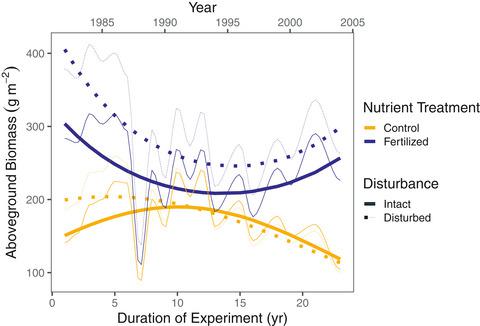当前位置:
X-MOL 学术
›
Ecol. Lett.
›
论文详情
Our official English website, www.x-mol.net, welcomes your
feedback! (Note: you will need to create a separate account there.)
Grassland ecosystem recovery after soil disturbance depends on nutrient supply rate.
Ecology Letters ( IF 7.6 ) Pub Date : 2020-09-17 , DOI: 10.1111/ele.13591 Eric W Seabloom 1 , Elizabeth T Borer 1 , David Tilman 1
Ecology Letters ( IF 7.6 ) Pub Date : 2020-09-17 , DOI: 10.1111/ele.13591 Eric W Seabloom 1 , Elizabeth T Borer 1 , David Tilman 1
Affiliation

|
Human disturbances alter the functioning and biodiversity of many ecosystems. These ecosystems may return to their pre‐disturbance state after disturbance ceases; however, humans have altered the environment in ways that may change the rate or direction of this recovery. For example, human activities have increased supplies of biologically limiting nutrients, such as nitrogen (N) and phosphorus (P), which can reduce grassland diversity and increase productivity. We tracked the recovery of a grassland for two decades following an intensive agricultural disturbance under ambient and elevated nutrient conditions. Productivity returned to pre‐disturbance levels quickly under ambient nutrient conditions, but nutrient addition slowed this recovery. In contrast, the effects of disturbance on diversity remained hidden for 15 years, at which point diversity began to increase in unfertilised plots. This work demonstrates that enrichment of terrestrial ecosystems by humans may alter the recovery of ecosystems and that disturbance effects may remain hidden for many years.
中文翻译:

土壤扰动后草原生态系统的恢复取决于养分的供应速度。
人为干扰改变了许多生态系统的功能和生物多样性。干扰停止后,这些生态系统可能会恢复到干扰前的状态。但是,人类以可能改变这种恢复速度或方向的方式改变了环境。例如,人类活动增加了诸如氮(N)和磷(P)等生物限制营养素的供应,这些营养素会减少草地的多样性并提高生产力。我们追踪了在环境和营养水平升高的情况下,农业受到严重干扰之后的二十年中草原的恢复情况。在环境养分条件下,生产力迅速恢复到干扰前的水平,但是养分添加减慢了这种恢复。相比之下,干扰对多样性的影响隐藏了15年,在这一点上,未受精地块的多样性开始增加。这项工作表明,人类对陆地生态系统的富集可能会改变生态系统的恢复,干扰影响可能会隐藏多年。
更新日期:2020-11-12
中文翻译:

土壤扰动后草原生态系统的恢复取决于养分的供应速度。
人为干扰改变了许多生态系统的功能和生物多样性。干扰停止后,这些生态系统可能会恢复到干扰前的状态。但是,人类以可能改变这种恢复速度或方向的方式改变了环境。例如,人类活动增加了诸如氮(N)和磷(P)等生物限制营养素的供应,这些营养素会减少草地的多样性并提高生产力。我们追踪了在环境和营养水平升高的情况下,农业受到严重干扰之后的二十年中草原的恢复情况。在环境养分条件下,生产力迅速恢复到干扰前的水平,但是养分添加减慢了这种恢复。相比之下,干扰对多样性的影响隐藏了15年,在这一点上,未受精地块的多样性开始增加。这项工作表明,人类对陆地生态系统的富集可能会改变生态系统的恢复,干扰影响可能会隐藏多年。









































 京公网安备 11010802027423号
京公网安备 11010802027423号